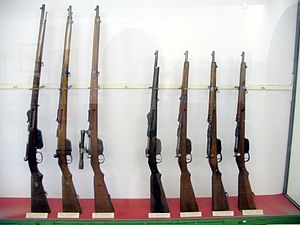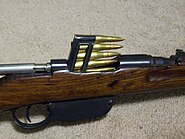| Steyr Mannlicher M1895 | |
|---|---|
 Various Mannlicher rifles and carbines. The long rifle on far left is an 1888 model and the carbine on the far left is an 1890 model. The rest are various 1895 models. | |
| Type | Service rifle, Bolt-action rifle |
| Place of origin |
|
| Service history | |
| In service | 1895–1945 |
| Used by | Austria-Hungary, Austria, Bulgaria, Czechoslovakia, Germany, Greece, Hungary, Italy, Netherlands, Ottoman Empire, Poland,[1] Portugal, Romania, Turkey, Yugoslavia |
| Wars |
Boxer Rebellion, Balkan Wars, World War I, World War II |
| Production history | |
| Designer | Ferdinand von Mannlicher |
| Designed | 1895 |
| Manufacturer | Steyr-Mannlicher |
| Produced | 1895–1921 |
| No. built | 3,000,000+ |
| Variants | M95 long rifle, M95/24 rifle, M95M rifle, M95/30 short rifle |
| Specifications | |
| Mass |
M95 long rifle: 3.8 kilograms (8.4 lb) empty M95/30 rifle: 3.36 kilograms (7.4 lb) empty |
| Length |
M95: 1,272 millimetres (50.1 in) M95/30: 1,000 millimetres (39 in) |
| Barrel length |
M95: 765 millimetres (30.1 in) M95/30: 480 millimetres (19 in) |
|
| |
| Cartridge | 8×50mmR Mannlicher, 8×56mmR Steyr / Hungarian, 7.92×57mm Mauser |
| Caliber | 8 mm caliber |
| Action | Straight-pull bolt action |
| Feed system | 5-round en bloc clip (stripper clip in M95/24 and M95M rifles), internal box magazine |
| Sights | Iron sights |
The Steyr-Mannlicher M1895 rifle is a bolt-action rifle, designed by Ferdinand Ritter von Mannlicher that used a refined version of his revolutionary straight-pull action. It was nicknamed the "Ruck-Zuck" ("right now" or "very quick") by Landsers (German slang for "troops"). It was initially adopted and employed by the Austro-Hungarian Army throughout World War I, and retained post-war by both the Austrian and Hungarian armies. The main foreign user was Bulgaria, which, starting in 1903, acquired large numbers and continued using them throughout both world wars. Numbers of these rifles also saw use in World War II, particularly by second line, reservist, and partisan units in Romania, Yugoslavia, Italy and to lesser degree, Germany. Post war many were sold as cheap surplus, with some finding their way to the hands of African guerrillas in the 1970s, and many more being exported to the US as sporting and collectible arms.
The M1895 is unusual in employing a straight-pull bolt action, as opposed to the more common rotating bolt-handle of other rifles. It consequently renowned for combining a high rate of fire (around 35 rounds per minute) with reliability and sturdiness, although this requires decent care and maintenance with an extractor that is vulnerable to breakage due to a lack of primary extraction. The weapon was issued with a ten-inch blade knife bayonet that was unusual in that the edge faced upwards when mounted on the rifle. The M1895 was originally chambered in the 8 mm M.1893 scharfe Patrone (8×50mmR Mannlicher) cartridge. Between the World Wars, both Austria and Hungary converted the majority of their rifles to fire the more powerful (8×56mmR) round. Greece[2] and Yugoslavia[3] converted at least some of their captured M1895s to 7.92×57mm Mauser, fed by stripper clips instead of the original model's en bloc clip system. This conversion was designated M95/24 in Greece and M95M in Yugoslavia. The M95/24 is often mistakenly attributed to Bulgaria, but 8x57mm IS was never a standard caliber of the Bulgarian military.[4] These conversions are prized by collectors for their relative scarcity and chambering in a commonly available round, but suffer from a fragile extractor and a lack of replacement parts.
The M1895 bolt also served as an almost exact template for the ill-fated Canadian M1905 Ross rifle, though the later M1910 used a complicated interrupted-thread instead of two solid lugs.
| Wikimedia Commons has media related to Mannlicher M1895. |
See also[]
- 35M rifle
- Dutch Mannlicher
- Weapons of the Austro-Hungarian Empire
- M1895 Lee Navy - An American straight-pull rifle
- Ross rifle - A Canadian straight-pull rifle
Notes[]
- ↑ "Karabin i karabinek 8mm wz.1895 "Mannlicher" - Kampania Wrześniowa 1939.pl". Kampania Wrześniowa 1939. http://1939.pl/uzbrojenie/polskie/bron-strzelecka/karabinek_8mm_wz1888_mannlicher/index.html. Retrieved June 5, 2012.
- ↑ "Greek Mannlicher M.95 Rifles and Carbines". Manowar's Hungarian Weapons & History. http://www.hungariae.com/Mann95Gr.htm. Retrieved June 22, 2012.
- ↑ "Yugoslavian Mannlicher M.95 Rifles and Carbines". Manowar's Hungarian Weapons & History. http://www.hungariae.com/Mann95Se.htm. Retrieved June 22, 2012.
- ↑ "Bulgarian Mannlicher M.95 Rifles and Carbines". Manowar's Hungarian Weapons & History. http://www.hungariae.com/Mann95Bu.htm. Retrieved June 22, 2012.
External links[]
- M95, M90, and identifying marks
- Modern Firearms - M95/30 (M1895)
- Photogallery of carabine Mannlicher M.95
Gallery[]
The original article can be found at Steyr-Mannlicher M1895 and the edit history here.



